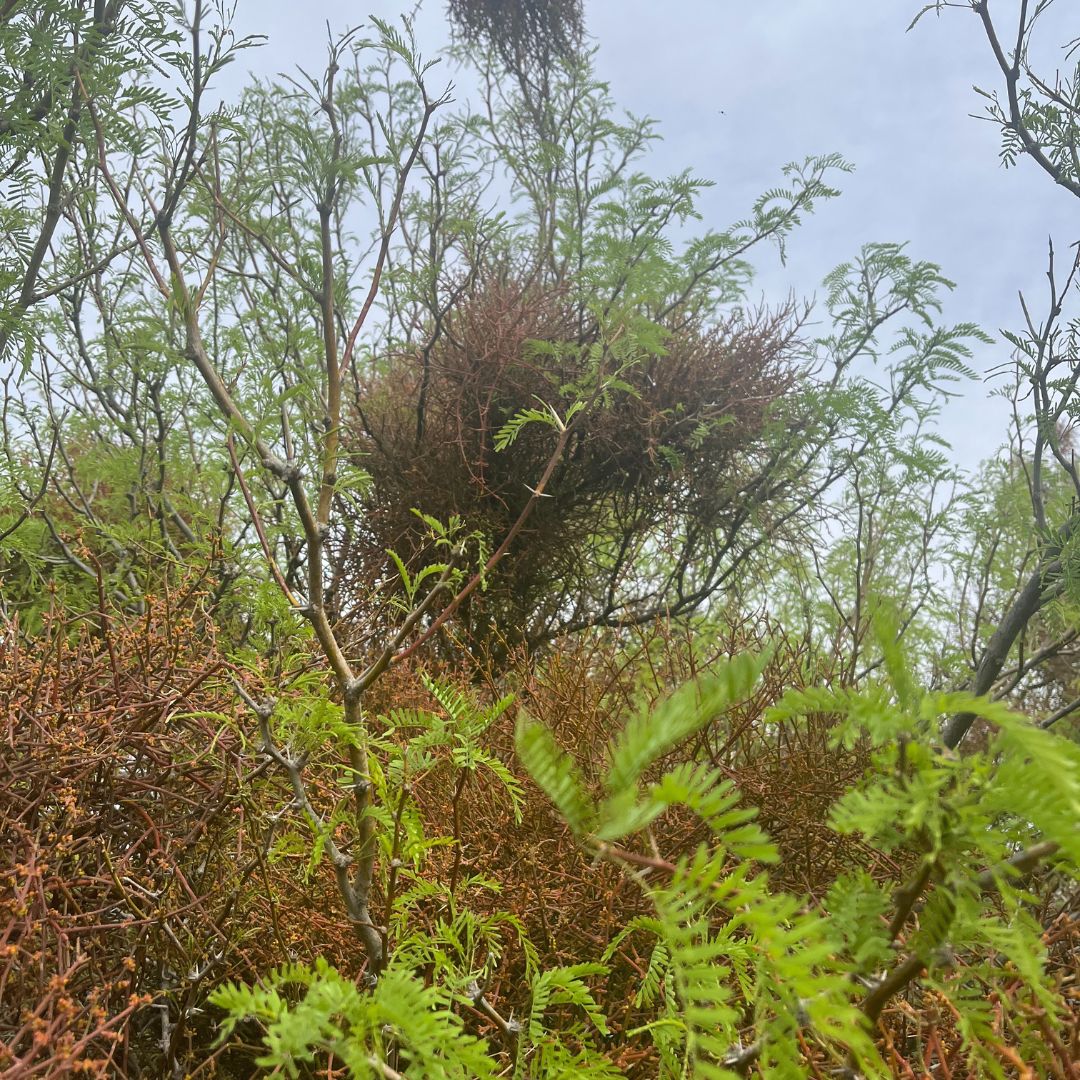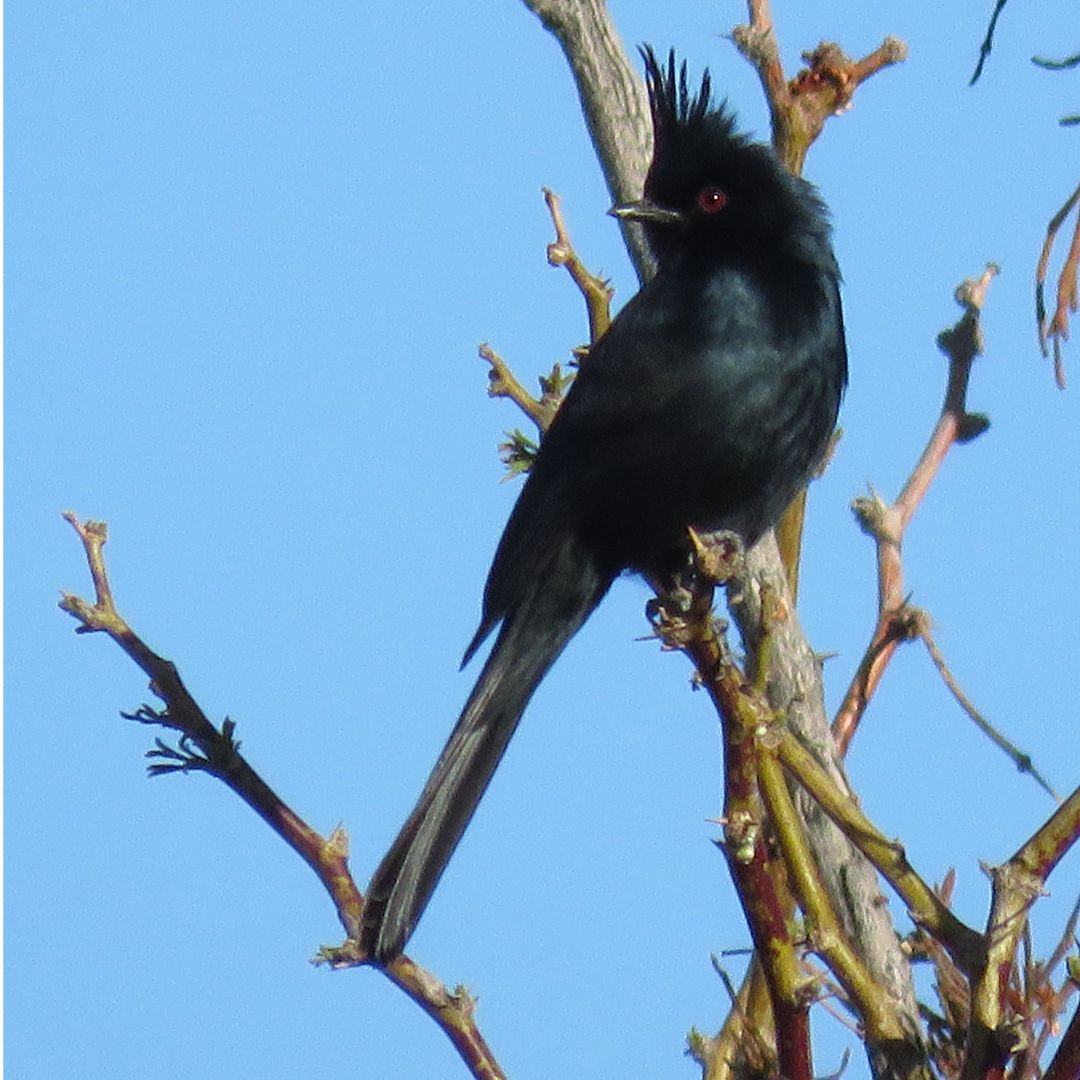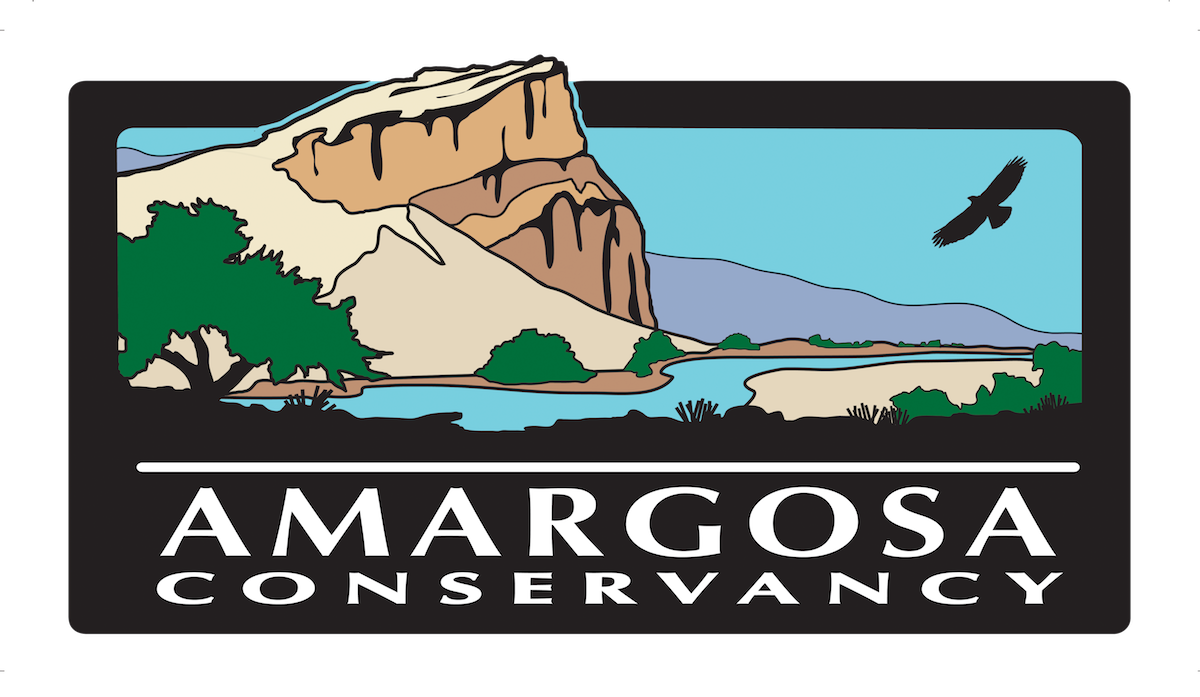By Morrigan DeVito, Restoration & Plant Stewardship Coordinator

Desert mistletoe (red clumps) growing in a mesquite
When you find a Phainopepla in a mesquite bosque, everything else comes into focus. I search for them in Shoshone Village by scanning the tops of the mesquites with my naked eye, looking especially around clumps of red desert mistletoe, one of their staple foods and a parasitic plant that clings to the mesquites and saps their nutrients. These birds spread the mistletoe wherever they go by pooping out the berries they eat onto other branches, so prime Phainopepla habitat is laden with hanging mistletoe. When at last I find a shiny black bird about the size of my fist, I hold my binoculars up. A male in all his glory: black head crest, red eyes, long tail, short pointed beak. He twitches, scanning left and right for rivals and potential mates, and flies away into a tangle of horizontal branches, a white patch flashing with each short wingbeat.
If you’ve slowed down enough to see the Phainopepla, the mesquite bosque reveals other wonders. Your eye catches the glint of an Anna’s Hummingbird gorget, that shiny magenta throat patch, as he turns his head, equally as alert as the Phainopepla to rivals, mates, and threats. Your hearing stretches to the faint squeaky clucks of Gambel’s Quail as their family winds through the big saltbushes, tall and densely guarding the path into this little desert world just a few steps away from the road, behind the Crowbar Cafe & Saloon.
Today I came out to Shoshone to explore with expert nest-finder and naturalist Len Warren, who loves Phainopeplas so much that, as he tells me, he doesn’t understand when people say they’ve seen too many of them on a bird walk. Each bird has its own story. A Phainopepla may be catching insects, displaying, fighting, or guarding a nest. Only when you slow down to watch their behavior does their story unfold.
We wind through the dusty trails, push through the saltbush and duck our heads beneath the bent mesquites until we reach a little clearing, or “Len’s Glen”, as he calls it.
“You can’t bring a big group in here,” Len says, “People don’t know how to sit still.”
So we sit very still. Even in a remote town like this, cars rumble through the desert’s quietness. We wait for the birds to get used to our presence. A Verdin, a sunny-faced southwest songbird, is the first to accept us, chirping and hopping through the branches and shaggy mesquite bark. Then we hear the faint rolling song of a Crissal Thrasher, and a soft chirp in return. There’s probably a nest right in front of us, unseen. A male and female are calling back and forth, careful not to draw too much attention to themselves.

Male Phainopepla
The Phainopeplas, Verdins, Anna’s Hummingbirds, Crissal Thrashers, and more species as yet unheard and unseen are all breeding here in Shoshone because there is ample shelter and food, something that can’t be said about other parts of the Amargosa River Basin where water and canopy is scarce. These birds all have unique micro-habitats for their nests, habitats that may differ ever so slightly with their needs. Verdins, for example, want to build a spherical nest out of bits of branches and twigs, but a Phainopepla wants to build a cup-shaped nest within the mistletoe. A Lucy’s Warbler, which now trills sweetly in the distance, wants to build nests in the cavities of the mesquite trees and have a well-canopied flight path to get to their nest in case they need to outfly a Cooper’s Hawk.
This reminds me that habitat restoration is not a one-size-fits-all solution. The Screwbean Mesquites, for example, are mostly dead in Shoshone Village, having succumbed to a fungal pathogen that has affected mesquites across the Southwest. But just because they’re dead doesn’t mean they’re barren, and to remove them would not be restorative. The criss-crossing branches, slumped over trunks, and heavy mesquite drapery are the exact habitat many breeding birds look for– nooks and crannies that are hidden to predators like hawks, coyotes, and even people. The bird’s don’t care if they’re dead.
One bird that is oddly absent from our observing is the least Bell’s Vireo, a threatened songbird whose Western population is vulnerable to habitat loss and brood parasitism from an increasing number of Brown-headed Cowbirds. Len tells me they’ve usually arrived and started singing by early April. It is now the second week of April. And, even stranger to him, we don’t hear the raspy voice of Black-tailed Gnatcatchers, a year-round resident usually ubiquitous in saltbush scrub. Where have they gone?
We just don’t know. Us birders like to make a lot of assumptions about where birds have come from and where they’re migrating, but the reality is that each bird is an individual. Unless we track every single one of them, we can’t say for sure where they’ve all come from or where they’re going. And as our climate gets hotter and drier, ranges and migration routes will shift as birds adapt and evolve at a scale we can’t see. That’s why protecting the Amargosa River Basin is so much more than protecting just our desert. We’re protecting organisms that unite habitats and landscapes, that don’t know the boundaries of towns, states, or even countries.
A female Phainopepla brings this into focus. She peers out of a mistletoe bundle, slate gray feathers shimmering in the trickle of sunlight shining through the shadows. Her kind have two breeding seasons, arriving in the Amargosa from coastal California to breed in the mesquites before heading back to oak-chaparral woodlands early summer to start the cycle over again. She will return to the Amargosa River Basin, or so we think, each year of her life.
May we remain focused on conserving the Amargosa River Basin so that she has a home to return to.
